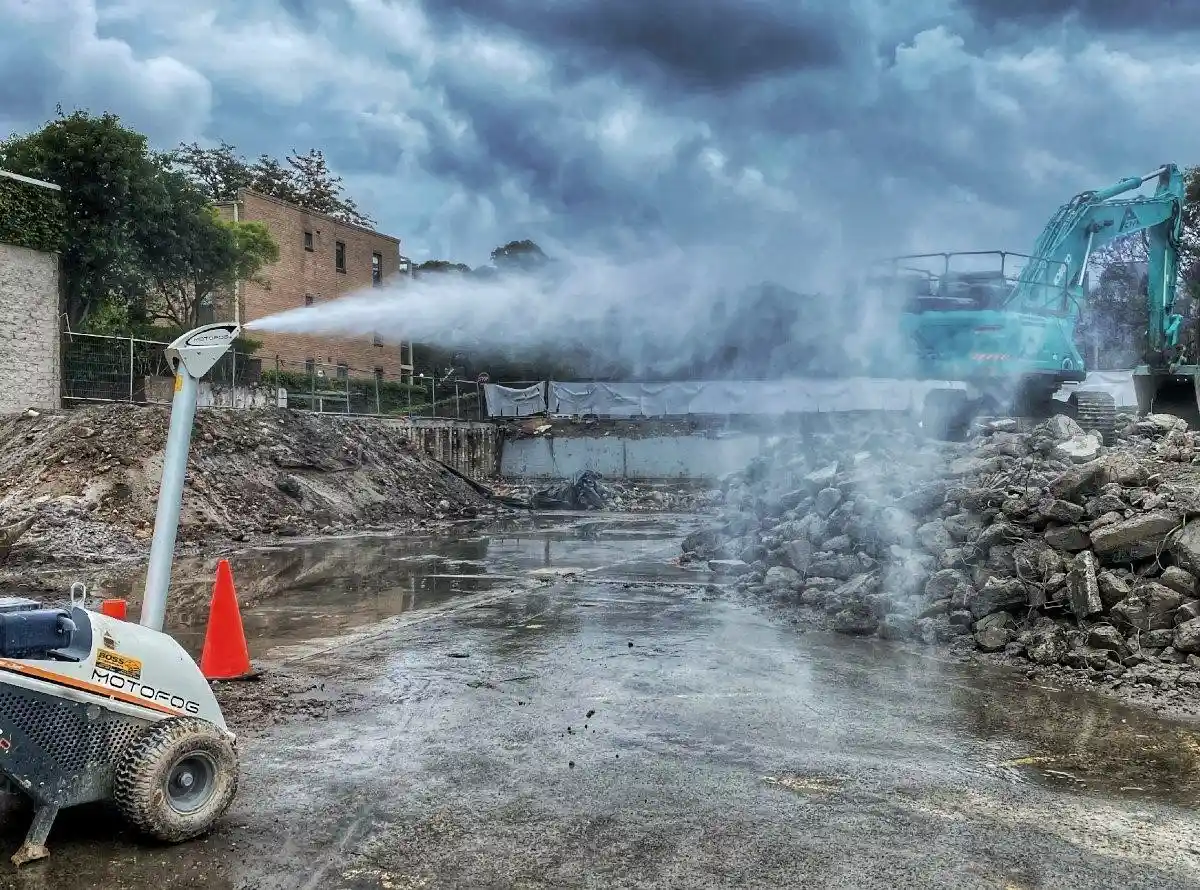
When it comes to construction site operations, the need for dust control is paramount for both worker safety and the long-term structural integrity of the finished project. A dusty construction site increases the risk of accidents and injury, reduces visibility and can accelerate corrosion on metal surfaces. It also leads to shorter operational time, increased expenses from greater cleanup needs, additional maintenance needs and increased energy consumption. Therefore, it’s in your organization’s best interest to implement strategies for reducing dust at your next construction project. Read on for five proven solutions for dust suppression.
Use Water for Everything
Water is the most basic yet essential component for controlling dust at a construction site. Water pressure can be used to suppress dust in several different ways, including Spraying water on the ground: To control dust, water must be sprayed on the ground to keep the dust from rising into the air. Spraying water on the equipment: Equipment such as cranes and excavators can be sprayed with water when they’re not in use or when they’re moving between tasks. This helps to reduce dust and other harmful emissions.
Spraying water on the walls: Spraying water on the walls of a building can reduce the amount of dust that’s transferred to the walls and ceilings. It’s important to note that simply watering down a construction site isn’t enough for effective dust control. Water must be sprayed at a high volume and pressure to effectively suppress dust, minimise airborne pollutants and keep water from damaging nearby surfaces.
Utilize High-pressure Spraying
The most effective way to suppress dust at a construction site is to use high-pressure water spraying. High-pressure water spraying is commonly used to clean construction equipment, wash away dirt and debris from work areas, and control dust by spraying high volumes of water on the ground. When high-pressure water spraying is used to control dust, air pressures of 2,000-5,000 psi can be achieved, which is more than enough to suppress dust in its tracks. Generally, high-pressure water spraying is one of the most reliable and effective dust suppression methods available. Not only does it keep the surrounding area relatively clean, but it also has a minimal impact on the environment and the equipment being used.
Install a Particulate Filter
Another effective solution for dust suppression is a particulate air filter. The air filter works to remove airborne particles such as dust, sand and other debris from industrial work environments. It’s commonly used in mining and construction operations as well as other industrial sectors. The air filter comes in a variety of styles and can be used in conjunction with other dust suppression methods. There are several different types of filters used for dust suppression, including Bag filters: Bag filters are cost-effective and easy to clean and maintain. They can also be used to capture a wide range of contaminants. Cartridge filters: Cartridge filters are another common type used in construction. They’re easy to install and remove, and they’re also easy to clean. Cyclones: Cyclones are another type of dust filter that’s commonly used in industrial environments.
Try Dust-fighting Technologies
Newer construction technologies can be used to suppress dust at a construction site. For example, wet-spray systems are commonly used for dust control and more efficient water usage. Another useful technology for dust suppression is electrostatic precipitation, which uses a high-voltage electric field to attract airborne particles and direct them to the ground. These types of technologies have very low maintenance requirements, and they’re also low-cost in comparison to other dust control methods. However, it’s important to note that they may not be an effective solution for every situation. For example, electrostatic precipitation may not be the best solution for construction sites where the surrounding soil is sandy, as the particles may be too big to be controlled.
Establish a Strong Communication Network
A strong communication network is essential to any successful construction project. Communication on a construction site is typically most effective when it’s two-way: workers talk to each other and managers communicate with workers. With this in mind, several strategies can be used to encourage communication and help reduce the amount of dust on a construction site: Install communication boards: Communication boards are a common tool used by construction managers to facilitate communication between workers and managers.
Create a quiet zone: A quiet zone is a designated area on the construction site where all workers must communicate in a soft voice to avoid disturbing the neighbours. Install warning signs: Warning signs can be used to alert workers to potential hazards in and around the work area, such as potential dust sources. Communication is especially important when there are potential dust sources nearby, such as roads that are being repaved. By encouraging workers to communicate with each other, managers can help reduce the amount of dust and other contaminants that are passed to the construction site.
Use Construction Equipment with Built-in Air Filters
Construction equipment with built-in air filters can help to reduce the amount of dust on a construction site. The filters help to keep the air clean while the equipment is being used and can also be used to water down the work area when water isn’t being used as a dust suppression method. This can help reduce dust pollution when working near neighbours and reduce the amount of cleanup required when the job comes to an end. Not all construction equipment comes with air filters, so it’s important to check the specifications of each piece of equipment before purchasing. The air filters can be installed on vehicles, cranes, excavators, tractors and other vehicles used for construction work.
Conclusion
Construction sites can be dusty environments, and construction dust can be harmful to workers, nearby residents and the environment as a whole. Construction professionals need to take steps to reduce and control dust on the site to protect themselves and others nearby. There are several different solutions for dust suppression that can be implemented at construction sites, including using water for everything, high-pressure spraying, installing a particulate air filter, trying dust-fighting technologies, and using construction equipment with built-in air filters.
Related posts:


Forex & Crypto
5 Best Ways to Earn Crypto While You Sleep in 2025
Categories
- Apps (1)
- Automotive (23)
- Beauty (7)
- Business (122)
- Celebrities (2)
- Digital Marketing (21)
- Ecommerce (2)
- Education (22)
- Entertainment (39)
- Events (6)
- Fashion (1)
- Features (4)
- Finance (1)
- Fitness (10)
- Food (2)
- Forex & Crypto (23)
- General (116)
- Health (48)
- House (61)
- Lifestyle (57)
- Marketing (8)
- Parenting (3)
- Pets (10)
- Real Estate (8)
- Safety and Security (14)
- Social Media (31)
- Sports (142)
- Technology (73)
- Travel (23)






















